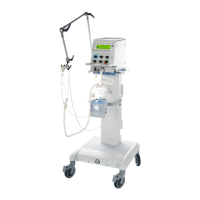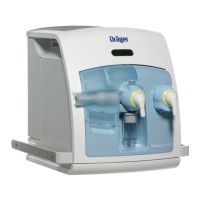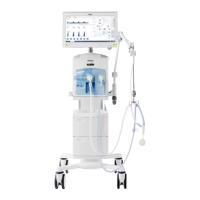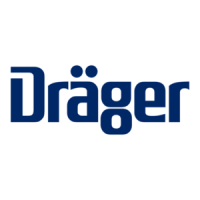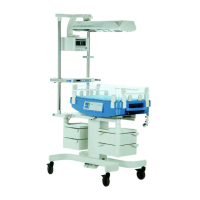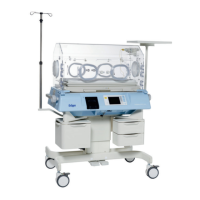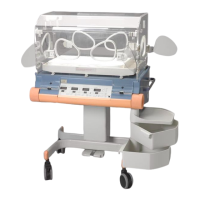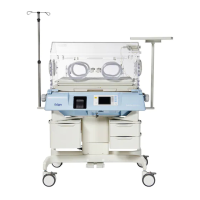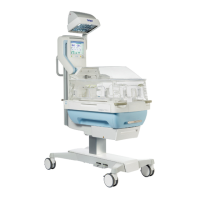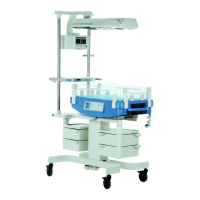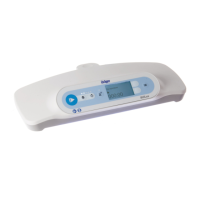What to do if Dräger Medical Equipment shows 'ventilator malfunction'?
- SSteve HerreraSep 23, 2025
If Dräger Medical Equipment is experiencing a ventilator malfunction, the ventilator is faulty and should be taken out of service.
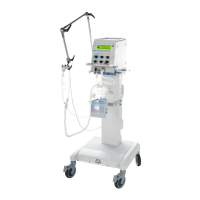
What to do if Dräger Medical Equipment shows 'ventilator malfunction'?
If Dräger Medical Equipment is experiencing a ventilator malfunction, the ventilator is faulty and should be taken out of service.
What to do if FiO2 is high on Dräger Medical Equipment?
A high FiO2 level in Dräger Medical Equipment can stem from a faulty O2 measurement, requiring manual calibration of the O2 sensor. Alternatively, the blender may be faulty, in which case the ventilator should be taken out of service.
What to do if FiO2 is low on Dräger Medical Equipment?
Low FiO2 in Dräger Medical Equipment may be due to an uncalibrated O2 sensor, necessitating manual calibration. If the problem persists, the blender might be faulty, requiring the ventilator to be taken out of service.
How to fix low airway pressure on Dräger Medical Equipment?
Low airway pressure in Dräger Medical Equipment can result from a leak or disconnection in the patient circuit, which requires a thorough check for leaks. It can also be caused by inspiratory or expiratory flow being set too low, which can be resolved by increasing the flow.
What causes disturbed flow measurement in Dräger Medical Equipment?
Disturbed flow measurement in Dräger Medical Equipment can occur if the flow sensor is faulty or disconnected, requiring you to connect the flow sensor or cable and calibrate the flow sensor. It may also be caused by a faulty flow measurement, in which case you should exchange the flow sensor. A faulty cable may also be the root cause, and you should exchange the cable.
What to do if there is a fault in rotary knob of Dräger Medical Equipment?
If there is a fault in the rotary knob of Dräger Medical Equipment, the ventilator is faulty and should be taken out of service.
What to do if Dräger Medical Equipment shows 'dirty flow sensor'?
A dirty flow sensor in Dräger Medical Equipment is caused by liquid in the flow sensor. Exchange the sensor insert and clean the sensor.
What does 'O2 measurement out of range' mean on Dräger Medical Equipment?
Out-of-range O2 measurement in Dräger Medical Equipment indicates that the O2 sensor is faulty or used up. Exchange the O2 sensor.
What does MV low mean on Dräger Medical Equipment?
Low MV in Dräger Medical Equipment can indicate that lung compliance has decreased, requiring a check of ventilation settings and adjustments as necessary. It may also be caused by low spontaneous breathing, which indicates a ventilator malfunction requiring you to take the ventilator out of service.
What causes pressure measurement out of range on Dräger Medical Equipment?
Out-of-range pressure measurement in Dräger Medical Equipment can be caused by liquid in the patient block, which requires you to replace the patient block. It may also be caused by condensation in the patient circuit, requiring you to remove the condensation. If the pressure measurement function is faulty, take the ventilator out of service. If the ID of the patient circuit is too small, use a circuit with less resistance.
| PEEP/CPAP | 0 - 20 cmH2O |
|---|---|
| FiO2 | 21 - 100% |
| Trigger Sensitivity | Adjustable |
| Type | Neonatal Ventilator |
| Ventilation Modes | SIMV, CPAP |
| Tidal Volume Range | 2 - 300 ml |
| Respiratory Rate | 150 bpm |
| Peak Inspiratory Pressure Range | 0 - 40 cmH2O |
| Trigger | Flow, Pressure |
| Alarms | High/Low FiO2 |
| Display | Color LCD screen |
| Power Supply | 100 - 240 V AC, 50/60 Hz |
| Weight | Approx. 15 kg |
Defines how terms like 'accessories' are used in the manual.
Clarifies the designation 'Babylog 8000' used for 'Babylog 8000 plus'.
Notes that screen reproductions may differ from the actual device.
Provides important info about hazardous situations that could cause death or serious injury.
Provides important info about hazardous situations that could cause minor injury or damage.
Provides additional information to avoid inconvenience during operation.
Defines personnel responsible for product maintenance.
Defines personnel who perform repair or complex maintenance.
Defines personnel who use the product according to its intended use.
Covers essential safety guidelines for device operation.
Details safety precautions specific to the Babylog 8000 plus.
Emphasizes the critical need to adhere to all instructions.
Highlights the importance of regular inspection and servicing.
Warns about risks associated with incompatible accessories.
Specifies environments where the device must not be used.
Guidelines for connecting other devices and approved combinations.
Addresses user responsibility for patient monitoring and device safety.
Details EMC compliance and potential interference sources.
Advises against reusing, reprocessing, or sterilizing disposable products.
Caution regarding the use of sterile-packaged accessories.
Guidance on securely installing accessories on the basic device.
Highlights that the device is intended for trained 'users' only.
Warns about potential suffocation if the emergency valve inlet is obstructed.
Warns against unallowed modifications and risks during MRI/hyperbaric use.
Details risks related to O2 concentration and nitric oxide delivery.
Covers risks of fire due to flammable substances, oxygen enrichment, or ignition sources.
Warns about electric shock and damage from liquid penetration.
Covers risks of injury from incorrect decisions or device overheating.
Addresses risks from damaged screens and device failure during life support.
Specifies the device's target patient group and application context.
Defines suitable and unsuitable environments for device operation.
Identifies key parts of the ventilator system on the trolley.
Details the layout and components of the user interface.
Lists primary functions including ventilation, monitoring, and data transfer.
Explains the arrangement of controls and how to adjust parameters.
Describes the purpose of different keys for mode and setting selection.
Details the various displays and how to navigate dialog windows.
Crucial safety guidelines before and during device setup.
Covers trolley setup, load limits, and secure device mounting.
Steps for installing sensors, valves, and breathing circuits.
Procedures for connecting gas and mains power.
Warns about the risk of injury or damage if the device is not securely mounted.
Highlights risks of patient injury from incorrect gases and explosion from oxygen/oil.
Step-by-step guide to powering on the device.
Instructions for initiating ventilation after device readiness.
Covers essential checks for patient safety before use.
Ensures battery is charged for the power failure alarm function.
Details how to set up ventilation modes and parameters.
Explains how to set and adjust the trigger sensitivity.
Describes ventilation with or without a pressure plateau.
Explains volume-controlled ventilation equivalent.
Details the Continuous Positive Airway Pressure mode.
Explains setting continuous expiratory flow independently.
Describes automatic inspiratory pressure regulation for tidal volume.
Details the principles and settings for HFV.
Covers closed suction techniques.
Instructions for performing manual breaths.
Essential safety information for using medication nebulizers.
Steps for sensor removal and deactivating flow monitoring.
Guidance on installing the sensor and reactivating flow monitoring.
Highlights fire risk from sensor wires during nebulization.
Steps for connecting the medication nebulizer.
Instructions for adjusting O2 concentration when nebulizing.
Procedure for safely ending nebulization.
Describes analog output, RS232, and impulse output capabilities.
Details data output options and connecting a printer.
Instructions for connecting to a patient monitor for data transfer.
Guides on printing single reports, trends, and all data.
Instructions for printing graphical waveform data.
Safe procedure for powering down the device.
Guidance on disconnecting gas supply safely.
Explains optical, acoustic signals and alarm priorities.
Procedures for silencing and re-enabling acoustic alarms.
How to acknowledge alarms after resolving the cause.
Guides on configuring manual and automatic alarm limits.
Covers viewing pressure, flow, and other measured parameters.
Explains how to view calculated resistance and compliance.
Shows how to view all configured and measured settings.
Covers viewing historical data and alarm log entries.
Lists sensors used and required calibration schedules.
Details O2 monitoring and the procedure for O2 sensor calibration.
Covers flow monitoring and the process for flow sensor calibration.
Instructions for deactivating and activating flow monitoring.
Shows how to view software version and operating hours.
Covers configuration of essential device settings.
Details settings for analog output and RS232 interfaces.
Procedure to follow in case of power supply interruption.
Lists common alarms, their causes, and suggested remedies.
Covers risks of infection and health hazards during reprocessing.
Steps for safely disassembling the ventilator and accessories.
Details classification, methods, and lists for reprocessing devices.
Covers reassembly and preparation for next use.
Guidelines for routine inspections and safety checks.
Provides intervals and measures for preventive maintenance.
Information on authorized repairs and filter replacement.
Covers end-of-life disposal and battery safety warnings.
Safe disposal instructions for O2 sensors.
Specifies operating temperature, humidity, and adjustable parameters.
Details device performance, measured values, and calculations.
Defines triggers for alarms and the device's safety concept.
Provides information on electromagnetic compatibility and immunity.
Explains the device's pneumatic circuit and modes of operation.
Details various ventilation modes like CPAP, IPPV, SIMV, PSV.
Covers advanced features like Volume Guarantee and HFV.
Explains how airway pressure, flow, and lung mechanics are measured.
